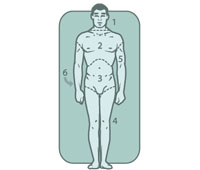Saving Lives: Perform a Focused Assessment

'saving lives assess 200x170'
HEAD-TO-TOE EXAM | VITAL SIGNS | PATIENT HISTORY
Gather a complete picture of a victim’s physical condition.
Do
>> Methodically apply pressure to all bones, move major joints, and check skin condition on each body part.
>> Express confidence and communicate what you’re doing at each step.
>> Use a firm touch—like squeezing an avocado—to locate wounds, swelling, painful regions,
or deformities.
>> Use all of your senses: Look, listen, feel, and smell for abnormalities.
>> Complete a full-body assessment before treating any non-life-threatening injuries (you don’t want to miss something now that could become a big problem later).
Don’t
>> Waste time and resources treating the first-identified injuries. Painful or obvious injuries may be superficial or less important than subtler ones.
>> Appear awkward, or communicate your own discomfort to the patient.
>> Use a tentative, light touch,
which may not uncover deformities, swelling, or other incident-related abnormalities.
>> Overlook medical history clues in pockets, packs, or on the victim (ID tags, insulin pumps, scars, etc.).
Be Systematic
Follow this order so you don’t miss a thing: (1) Head, neck, face; (2) clavicle, shoulders, chest/ribs; (3) abdomen, pelvis, groin; (4) lower extremities; (5) upper extremities; (6) back, buttocks, flanks.

VITAL SIGNS | HEAD-TO-TOE EXAM | PATIENT HISTORY
Establish a baseline and get insight into tricky diagnoses.
PATIENT HISTORY | VITAL SIGNS | HEAD-TO-TOE EXAM
Prevent Problems
First-aid training isn’t a passport to risky behavior. Use these tips to decrease your odds of injury.
1) Expose only one person at a time to localized hazards. Spread out, but stay within sight.
2) Don’t shortcut—especially when descending a peak, returning to a trailhead, or when you’re lost. Retrace your inbound path.
3) Stay together. Individual party members are easily disoriented.
4) Beware of “expert” friends. Assess group ability and plan activities to accommodate all.
5) Practice using new gear and skills in a controlled setting before beginning a committed trip. Emulate expected conditions close to home first.